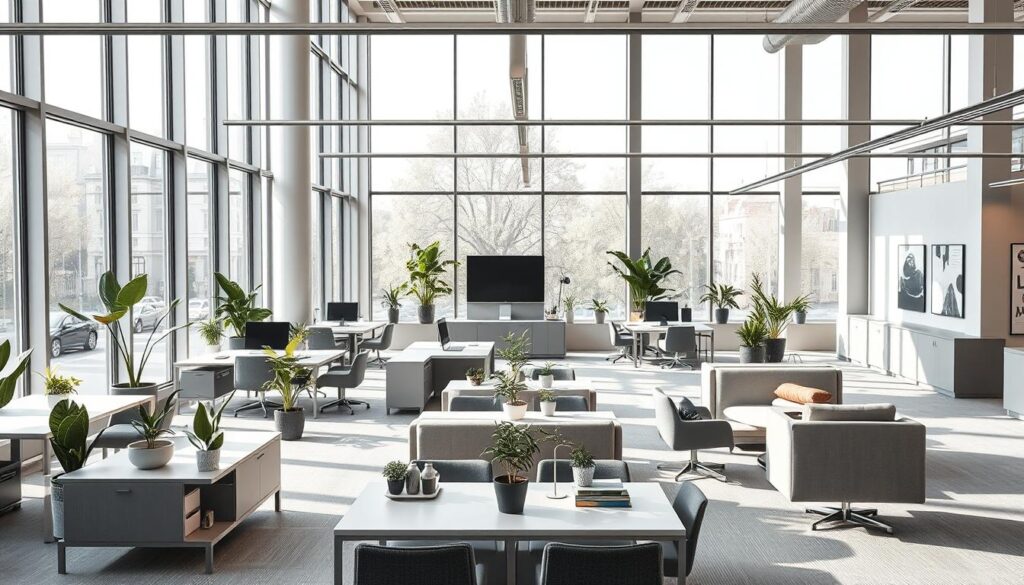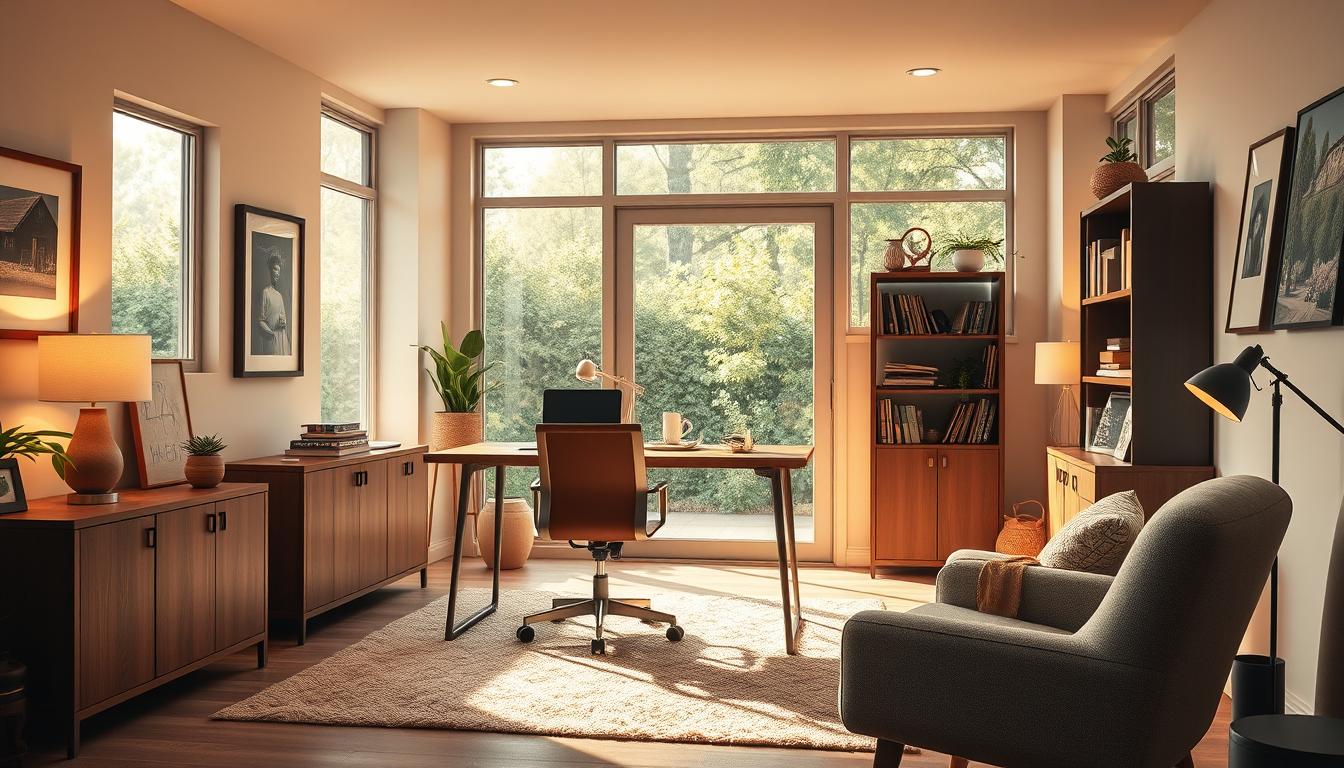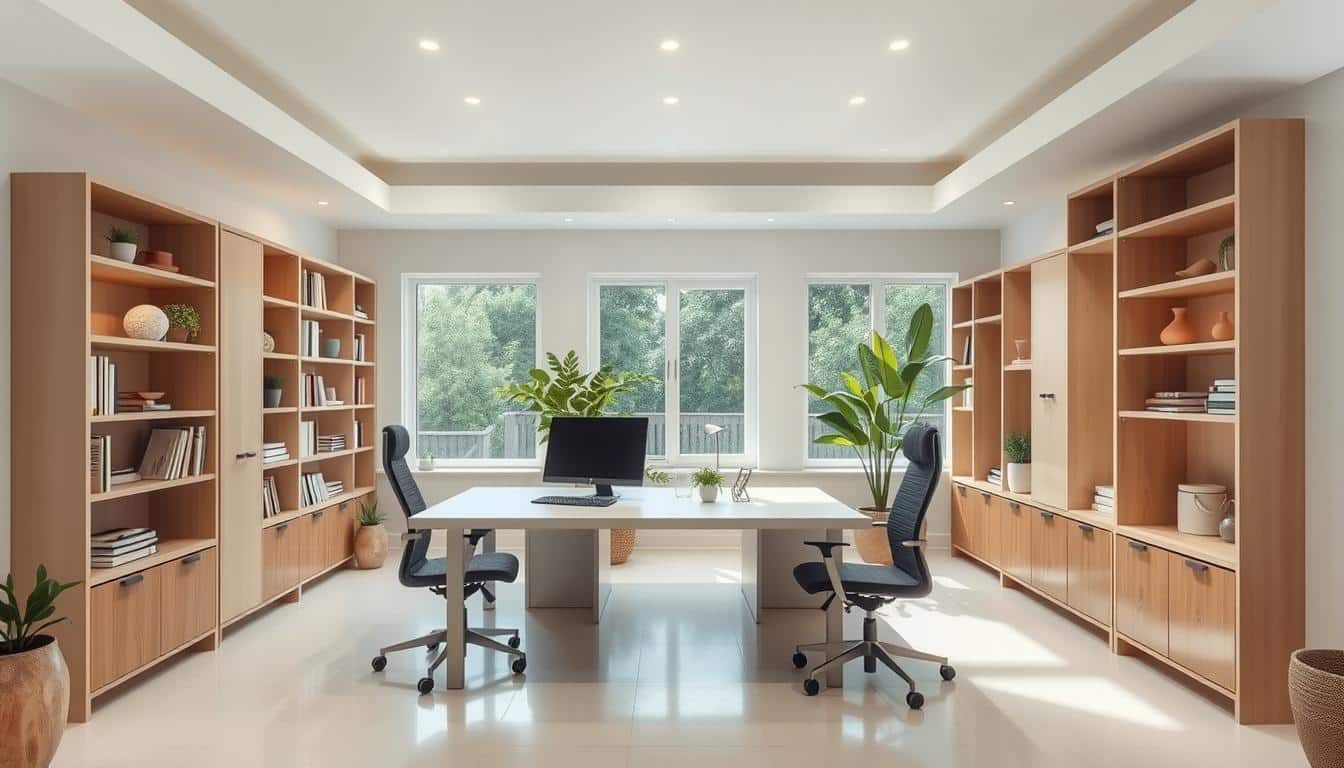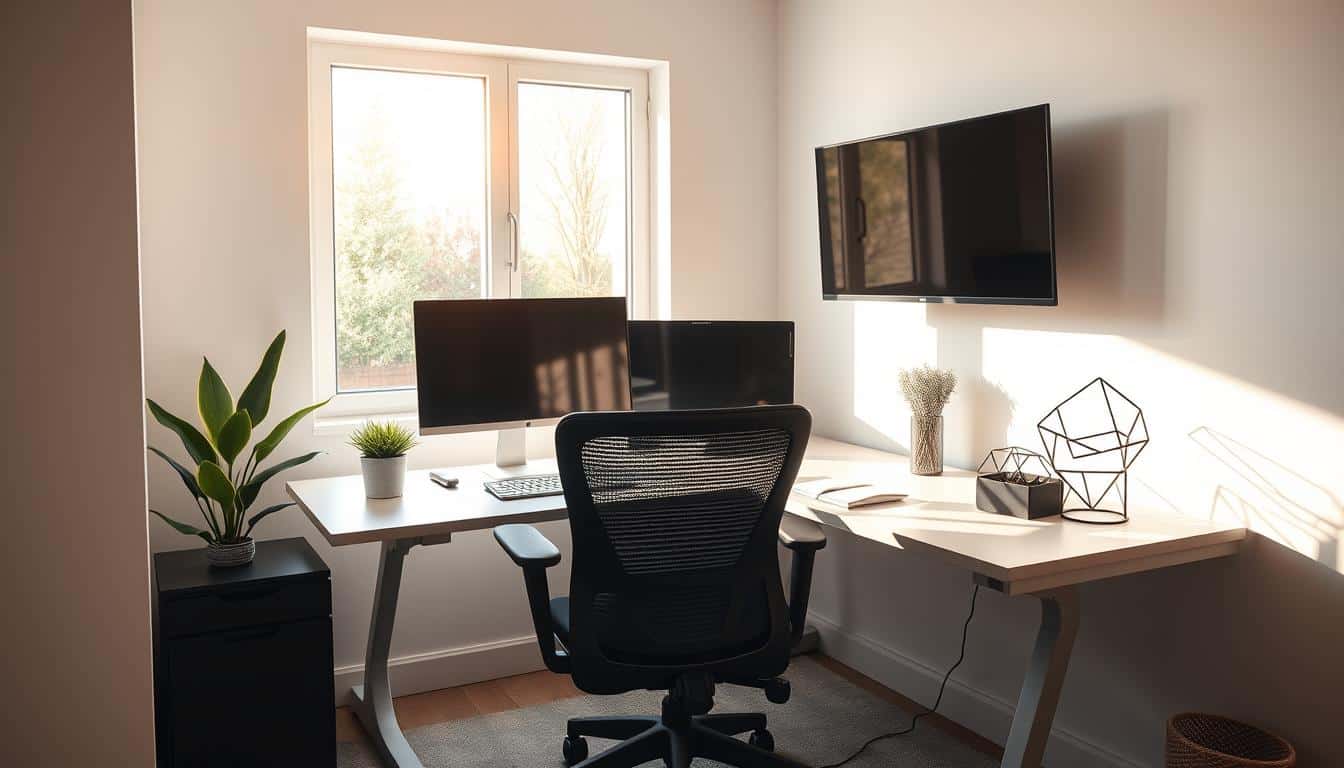Making your workspace efficient is key to increasing productivity. A workspace that’s well-thought-out helps workers concentrate better and reduces distractions. This sets the stage for smoother operations. Knowing how important workspace design is can help your team do their best work. In this article, we’ll look at ways to make your workspace better for getting things done.
Understanding the Importance of an Efficient Workspace
An efficient workspace boosts worker productivity and helps people work together better. It’s built to improve how well people perform and feel. This shows a company really cares about its workers. Workplaces that support focus and creativity help teams succeed.
The Impact on Employee Productivity
A well-planned workspace can make employees more productive. Studies show that less clutter and a good layout can help people focus and reduce distractions. Workers in such places often feel more fulfilled and happy with their work.
Influences on Team Collaboration and Innovation
A good workspace makes it easier for teams to work together and come up with new ideas. Having access to tools and spaces that promote teamwork makes employees want to share and interact more. This environment is key for solving problems and creating new plans for the company.

Mapping Your Workspace for Maximum Efficiency
Starting with understanding current workflows is key to creating an efficient workspace. Facility mapping lets organizations see which activities add value and increase revenue. It’s important to know which parts of the physical layout help productivity and which don’t.
Identifying Value-Added Activities
For better productivity, businesses need to find activities customers think are essential and will pay for. This means recognizing what actions truly push revenue forward. Here are steps to consider:
- Conduct a thorough evaluation of existing workflows.
- Engage employees in discussions regarding their daily activities.
- Prioritize activities that result in customer satisfaction and profitability.
Creating Physical Layout Maps
Once you know what activities add value, making detailed maps of your space is crucial. These maps show how space is used and where you can improve. Businesses should aim to:
- Map out each department to see the workflow.
- Highlight areas meant for productive activities.
- Figure out how much space supports these activities.
A strategic plan for facility mapping will enhance operations, manage resources well, and uncover chances to boost productivity.
Show the Flow of Work to Identify Bottlenecks
Boosting workplace efficiency starts with knowing how work moves. Workflow analysis methods spotlight where things get stuck. A spaghetti diagram can show us how resources and people move every day. It makes finding bottlenecks easier.
Creating a Spaghetti Diagram
A spaghetti diagram tracks how people and materials move around. It shows the paths everything takes. This helps find wasteful steps and too much movement. It’s key to seeing where work gets slowed down. Good diagrams keep things moving smoothly and reduce delays.
Measuring Movement and Waiting Times
It’s important to measure how long tasks take and the movement involved. Tracking how long people wait for materials or answers helps find bottlenecks. Focusing on these delay hotspots lets teams make operations more efficient. This boosts productivity.
Regular Observation of Workplace Dynamics
It takes more than just knowing the theory to understand workplace dynamics. Active management engagement through regular observation is key. By joining in daily operations, leaders can spot issues and appreciate employee contributions directly. This not only fixes operation flaws but also tells workers they are valued.
The Role of Management Participation
When managers take part in observing the workplace, they connect better with their team. Being on the ground, they see interactions and processes as they happen. This involvement helps them to:
- Identify challenges faced by teams in various tasks
- Pinpoint areas requiring improvement or adjustment
- Encourage collaboration and build rapport with staff
Gathering Insights Through Employee Feedback
Getting feedback from employees is crucial for improving workplace dynamics. It creates an open and trusting environment when workers voice their ideas. Collecting feedback carefully lets companies:
- Gain insights into employee morale and satisfaction
- Incorporate suggestions that lead to positive changes
- Empower employees and promote a sense of ownership
Optimize Your Workspace for Better Output
Making your workspace better involves listening to your team. Their day-to-day experiences give clues on improving productivity. By including them, the workspace can meet their needs, making everything run smoother and more efficiently.
Involving Employees in Optimization Decisions
When you get your team’s help, you learn a lot. They share what’s tough and what changes could help. For example:
- Conducting surveys to assess comfort and functionality.
- Hosting focus groups to discuss workspace preferences.
- Encouraging feedback on specific layout proposals.
Acting on what employees suggest makes a workspace that works better for everyone. This encourages team spirit and cooperation.
Reducing Unused Space and Streamlining Workflow
Cutting down on empty space can really boost how much gets done. By figuring out which spots aren’t used much, you can make everything flow better. Here’s how:
- Analyzing traffic patterns to determine frequently used spaces.
- Reconfiguring furniture and equipment for better accessibility.
- Implementing open and flexible areas that encourage movement and collaboration.
Tackling unused space helps create a place where everyone likes to work together. It makes for a better, more productive atmosphere.
Leveraging Technology to Enhance Efficiency
Using the latest technology in workspace design boosts productivity and teamwork. Tools for teamwork improve how team members communicate. This makes handling projects smoother. Automation also helps by doing routine jobs for us. This lets workers focus on more important tasks. Data analysis is key in spotting trends and making the workspace better. Technology is vital for a more efficient work environment.
Incorporating Collaborative Tools
Teamwork tools are crucial for effective collaboration. They allow instant messaging, sharing files, and keeping track of projects. Using programs like Slack, Microsoft Teams, and Trello changes the game. They make sure teams are on the same page. Adding these tools cuts down on delays and misunderstandings.
Utilizing Automation and Analytics
Automation manages simple jobs. It can handle everything from setting up meetings to answering customer questions. Apps like Zapier and Asana make processes automatic. This gives employees more time for the core parts of their jobs. Linking automation with data analysis helps businesses understand how they’re doing. It leads to better decisions and ongoing improvements.
Creating a Culture of Collaboration
Creating a strong culture of collaboration is key for solving new problems and improving how a team works together. Having regular team meetings and brainstorming helps. This makes a space where everyone can share ideas freely. It boosts creativity and group feedback. Such interactions build trust and foster a sense of belonging in the team. This is crucial for working effectively together.
Regular Team Meetings and Brainstorming Sessions
Team meetings are a time to update each other, talk about challenges, and find chances to work together. Having these meetings regularly helps team members talk openly. This shows they are all in on the same goals. Brainstorming sessions offer a way to come up with new ideas in a free but structured setting. This lets teams use different viewpoints to solve tough problems quickly.
Implementing Collaborative Platforms for Seamless Communication
It’s important to use collaborative platforms to boost how teams talk and work together. These tools help with chatting in real-time, sharing files in one place, and managing projects. This makes sure everyone is up-to-date and active. Adding technology to daily tasks helps increase teamwork. This leads to better innovation and more work getting done on different projects.
Designing an Innovative Office Space
Creating a workspace that’s innovative involves a smart approach to design. It meets various work styles needs. By understanding what different employees need, companies can create an area where everyone works best. This method shows how crucial the office layout is for different activities, like solo work or group projects.
The Importance of Layout for Different Work Styles
An office layout must mirror the various work styles in a company. Think about adding:
- Quiet zones for deep focus tasks
- Collaborative spaces equipped for team brainstorming
- Relaxation areas to promote informal interactions among staff
This mix helps keep employees engaged and boosts productivity.
Incorporating Elements That Foster Creativity
To boost a workspace’s innovation, creative touches are key in design. Adding lively colors, comfy furniture, and art can make an area more inspiring. Consider:
- Using vibrant colors that inspire energy and creativity
- Choosing flexible furniture that adapts to different group needs
- Incorporating greenery which promotes relaxation and boosts morale
By focusing on these elements, companies can build a space where employees excel in diverse roles.
Prioritizing Employee Well-being in the Workspace
A work environment focused on employee well-being boosts productivity and engagement. Allowing flexible arrangements helps employees balance work and personal life. It makes them feel empowered and more devoted to their jobs.
Implementing Flexible Work Arrangements
Flexible work is key to employee well-being. It offers options like working from home, changing hours, or shorter workweeks. These choices lead to happier workers, less stress, and keeping talented staff.
- Improved job satisfaction and morale.
- Reduced stress levels among employees.
- Increased retention of top talent.
Creating Supportive Leadership Structures
Leadership that supports is crucial for a healthy work environment. Checking in with staff and being available makes a big difference in well-being. Leaders who listen and act on feedback build trust and respect. This leads to better teamwork, innovation, and a more committed workforce.
- Enhanced collaboration and innovation.
- Stronger team dynamics and relationships.
- A more resilient and engaged workforce.
Conclusion
Making a work area efficient is key to boosting productivity and building a good workplace vibe. By planning well, using tools for teamwork, and often changing the layout, companies can make spaces that not only increase work done but also spark new ideas in their team. Each method used is important for making work processes better and meeting the needs of employees, which is crucial for lasting success.
Always trying to improve how the workplace looks and its rules makes for an exciting setting where employees feel important and active. By focusing on these areas, businesses can set up a strong system for making productivity better that works well for everyone on the team. Working on the workspace isn’t just a one-time thing; it needs a constant effort to change and grow as the ways we work and what employees say change.
In the end, the work to make workplace efficiency better is key for reaching big goals over time. Companies that really care about their teams and their surroundings will see not just more work done but also a workplace that grows strong loyalty and happiness.



